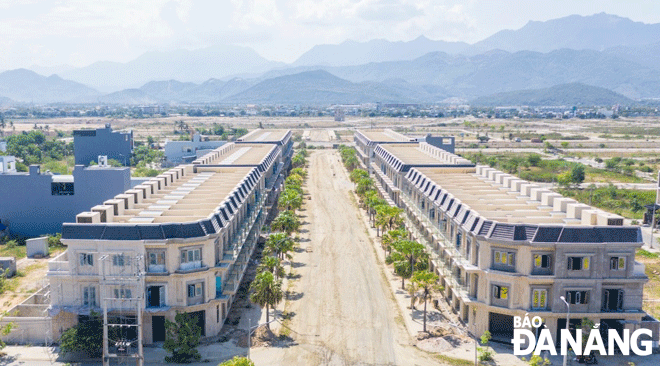An eco-town to take shape in Da Nang's Hi-tech Park subdivision
The Da Nang Hi-Tech Park subdivision will cover an area of over 3,655 hectares (except for the existing area of 1,952 hectares planned for Hi-Tech Park . The population in subdivision is projected to reach more than 194,000 by 2030 and nearly 253,000 by 2045. The subdivision planning which is developed by Viet Nam’s National Institute of Urban and Rural Planning under the Ministry of Construction is being widely publicized to gather public opinion and collect feedback from Da Nang communities.
 |
| The development of a new urban area is underway in Hoa Hiep Nam Ward, Lien Chieu District. Photo: TRIEU TUNG |
Setting scope of planning for the Hi-Tech Park subdivision
The hi-tech park subdivision has the potential of becoming a green core, a high-tech park belt, a hi-tech service centre and an administrative centre along the northern gateway to Da Nang in line with Da Nang’s Master Plan for its major developements by 2030, with a vision towards 2045 approved by the Prime Minister.
The subdivision will be designed with Hoa Khanh and expanded Hoa Khanh industrial parks, auxiliary zone serving the Hi-tech Park, Dedicated Information Technology Industrial Park No.2, along with the Northern Coach Station, plus already built- urban areas and new ones currently under construction in Hoa Son and Hoa Lien communes, both in Hoa Vang District, and Lien Chieu District’s Hoa Hiep Nam.
The subdivision is bounded by DT602 road to the south, Cu De River to the north, Nguyen Luong Bang Street to the east, and the Hi-tech Park to the west. The subdivision will cover an area of 3,655ha, and its population is expected to reach 73,600 by 2030, an increase of about 51,100 compared with the current population of 22,500.
The hi-tech subdivision is considered to be a new urban area in Da Nang’s inner city and an international-standard tourist service center after its urban infrastructure undergoes the renovation and embellishment works. Spatial organization of the subdivision will be based on the development of urban traffic structure linking with national highway 14G, DT 602 road, extended Hoang Van Thai road, DH 2 road, and the Western ring road.
Planning and design ideas for Hi-tech subdivision
The hi-tech subdivision planning consists of 11 residential areas, 3 independent functional areas and 1 cemetery.
The key idea for the hi-tech subdivision planning is to develop it into an international-standard hi-tech center, a smart green city, a science- and knowledge-based city, a center for innovation and creativity, and a leading destination in Viet Nam for startups and top tech investors at regional and global levels. The focus will be on developing modern and higher density new urban areas in a synchronous manner, as well as combining with renovation, embellishment and rebuilding of the already built-areas in a bid to create a perfect urban subdivision to provide housing for urban dwellers. Special attention will be paid to creating designs for urban axes, landscapes and key focal spaces in the subdivision to achieve harmony with nature. The hi-tech subdivision planning aims to setting up an infrastructure hub and and a traffic hub for the entire city connecting Da Nang’s urban centers and regional infrastructure system in a synchronous manner. Importance will be attached to establishing technological development zones and high-quality training centers in an attempt to build new tech products to serve the needs of urban development while developing high quality human resources for the city.
Urban space development will be based on a modern urban model with a focus on using elevated land areas for new developments while ensuring harmony between landscape and architecture, making the hi-tech subdivision resilient and sustainable. High-rise buildings will be built in the extended Nguyen Tat Thanh Street, DT 602 road, along Nguyen Luong Bang Street, and the Western ring road. The heed will be paid to developing urban axis and urban core of the subdivision in harmony between high-rise commercial buildings and apartment buildings, and low-rise residential buildings, already-built areas and other social infrastructure works.
The development of energy-efficient and eco-friendly houses is encouraged in the hi-tech subdivision. The urban center of the subdivision will cover both sides of such major streets as the extended Nguyen Tat Thanh Street. A park near Bau Tram Lake and the buffer zone along the Cu De River, a regulated lake, a system of drainage canals in Hoa Vang District’s Hoa Lien Commune will be used for shaping green spaces for the subdivision. The heed will be paid to creating a connection of green spaces between urban areas. Large-scale public facilities will be built on Nguyen Luong Bang, DT 602, DT 601, and Nguyen Tat Thanh streets.
Reporting by TRIEU TUNG – Translating by H.L